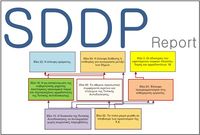SDDP Engaging citizens to reinvent democracy
|
Executive Summary
This paper reports the results of the first of a series of workshops organized by Future Worlds Center under the auspices of the Cyprus Presidency of the Council of the EU. The dialogue was implemented in the context of the “Engaging citizens to reinvent democracy" project. The project was born as an initiative of Future Worlds Center. The one-day workshop is organized as an interactive co-laboratory, fully utilizing up-to-date methodologies and technologies of the science of structured democratic dialogue. The aim of this co-laboratory is to bring together Cypriots of different age groups in an attempt to envision, conceptualize and design new models of democratic governance. The structured democratic dialogue methodology is a highly effective methodology that is employed for conflict resolution and which ensures that a variety of stakeholders represents the problem system of concern and that all stakeholders’ opinions are equally represented in the dialogic process. The workshop was facilitated by Dr. Yiannis Laouris,Zoe Apostolidou and Eleni Michail.
This Co-Laboratoty was organized using the Structured Democratic Dialogue Process (SDDP) approach within the context of a rich web-based communication environment. It is categorized as one of many organised under the running title Reinventing democracy.
The Triggering Question (TQ) was
What are the characteristics of an ideal future system of governance?
In response to the TQ, the participants came up with 54 characteristics, which were categorized in 9 clusters. Following the voting process, 28 ideas received one or more votes and were structured to create the influence MAP shown below.
According to the participants of this workshop, the characteristic appear to be the most influential was:
- Characteristic #26, Independent interactive media created by citizens for citizens
The participants had time to discuss and reflect on the influence map and in general agreed that the arrows in the map made sense to them.
In sum, the application of the SDDSM process empowered the team to identify the potential characteristics of an ideal future system of governance.








